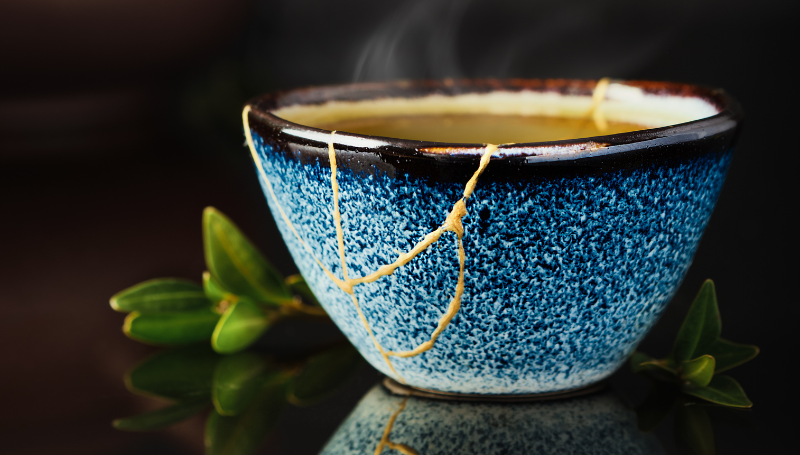Kintsugi and wabi-sabi

The ethos of wabi-sabi is beautifully captured in the practice of kintsugi, a physical expression of embracing imperfection. Kintsugi translates to golden joinery or golden repair, and is the art of repairing broken pottery by fusing it together with gold. Rather than the breaks being something to hide or discard, the random cracks and imperfections are embraced. The wabi-sabi aesthetic of broken parts are celebrated for giving the object character.
The psychology of wabi-sabi
So-called beauty standards are applied to everything from the food stocked on supermarket shelves (engineered to look a certain way), to our physical appearance, signified by the rise of plastic surgery and a beauty industry worth billions upon billions of dollars. Any sign of imperfection is judged negatively. In many ways, modern culture is in denial of the natural state of impermanence.
In physical form, this is easier to detect. We might wish to hide wrinkles, have a body sculpted to fit the idealized images seen in magazines and social media, or manicure our meals to look Instagram-ready. But what about the psychology of wabi-sabi? How does this philosophy apply to the inner world?
Three categories of perfectionism
Perfectionism has been widely studied in the field of psychology, with strong correlations to a host of negative outcomes, from stress, depression, to low self-esteem. Psychologists Paul Hewitt and Gordon Flett identify three main categories of perfectionism:
- Socially prescribed perfectionism: the belief that other people expect you to be perfect.
- Other-oriented perfectionism: placing perfect standards on other people.
- Self-oriented perfectionism: expecting flawlessness from yourself.
There is a paradox at the core of perfectionism — the more we strive to be perfect, the higher our expectations, and the less likely we are to achieve or experience what we crave. Perfectionism isn’t productive or skilful, but leads to a sense of suffocation or self-criticism. Although a philosophy stretching back hundreds of years, wabi-sabi is a useful solution to this modern issue.
6 Ways to incorporate wabi-sabi into your life
So how do you make wabi-sabi a way of life? Before we dive deeper into that, remember that wabi-sabi is a spiritual philosophy. It’s not a hack to find happiness, or another habit to track. It’s a mindset and way of life, a dedication to living aligned with certain values. And be warned: striving to always find joy and contentment in each moment is another form of perfectionism disguising itself! The below steps can modestly lead you along the path of wabi-sabi:
In my Aztec reading, my guide was careful to point out that my perfectionist tendencies weren’t all bad — my attention to detail and desire to have everything in place works well in professional settings and structuring my life. Everything is a matter of balance, though, and when applied to my everyday life, perfectionism just isn’t an optimal approach. It’s what Buddhism identifies as dukkha, or suffering.
The first step to incorporate wabi-sabi is to acknowledge the areas where you do crave perfection. What patterns do you notice? Feelings of disappointment or dissatisfaction could signal high expectations. If you often have mental images of how life “should be,” then it’s worth addressing this and setting the intention to change. This doesn’t mean sacrificing standards or ambition but finding a greater balance.
2. Identify what perfectionism means to you
By this, I mean on a deep psychological and emotional level. Before embracing wabi-sabi, the defense mechanisms and core beliefs that motivate your perfectionist behavior have to be deconstructed and understood. What beliefs do you have about perfectionism? Do you believe you won’t be loved or respected if you’re not perfect? Do you feel that life should always work out the way you’d like it to?
Perfectionism can often be the mind’s tendency to avoid suffering of all kinds. For example, envisioning everything going completely to plan can create a sense of relief or control. But when things don’t go to plan, how do you respond? Maybe you use anxiety as a way to avoid feelings of anxiety or uncertainty. Know that this approach is futile, and, as taught in Buddhism, will only create additional, unnecessary suffering.
3. Reflect on impermanence

If you fully embrace wabi-sabi, the lessons will come to you. Part of the learning lies in the spiritual practice of embracing impermanence. Notice how everything is always changing, despite the mind’s tendency to crave fixed things. Another aspect of Buddhism known as aniccā, talks to this ever-changing quality of reality. Wanting things to remain the same, or denying this, is another cause of suffering. On the other hand, acceptance of impermanence leads to deeper peace and happiness.
Another Buddhist principle of non-attachment is crucial. Attachment is sometimes referred to as grasping. You’ll likely intuitively understand the feeling when you try to hold onto, or grasp at, moments in life. Maybe your relationship is coming to an end, and you’re holding on through fear of the unknown. Maybe you are stuck in nostalgia, holding onto the past rather than looking to the future.
The better you’re able to practice non-attachment, the more life will flow with ease. Beauty will be found in seeing how every moment is as delicate as a falling cherry blossom — and that’s what makes it valuable.
4. Embrace imperfection with reframing
So much of happiness comes down to your approach to life’s events, and not the events themselves. The ability to embrace imperfection isn’t easy, as it requires a significant reframe. Rather than seeing unwanted or imperfect qualities as hurdles, what if you could see them as opportunities to grow? Adopting a growth mindset allows you to see what was previously imperfection to be opportunities.
This is wide-reaching. For example, if you have a perfect idea of how to spend an evening with your partner, you might become overly sensitive to things not going well. But what if any hiccups or conflict were opportunities to reconcile, to get to know each other more deeply? If you have a perfectionist view of success, what if you focused more on who you were becoming in your journey?
Part of incorporating wabi-sabi is to embrace a more simple, natural-orientated life. Rather than always striving for the ideal, social-media-worthy lifestyle, what if you could focus on the basics? Cultivating a gratitude practice for life’s small joys, along with a deeper connection with nature, be it through forest bathing, running, walking barefoot, or just being aware of the abundant gifts Mother Earth provides all around.
Every day we are force-fed images of the perfect lifestyle. What if wabi-sabi allowed you to rebel? We become so busy chasing and striving for an image of perfection that we miss what’s right in front of us. What would change if you fully embraced your life, exactly as it is? That doesn’t mean becoming passive towards things that have to change. Instead, it means taking a deep breath and letting go of resistance, in a way that allows you to gather your energy to direct it to what’s most important.
6. Cultivate compassion
Compassion, another central teaching of Buddhism, is closely linked with wabi-sabi. It encourages us to embrace that everyone has flaws, and insecurities. It acknowledges that each of us suffer with life’s setbacks. It doesn’t seek to minimize or ridicule the very real pain that can come from disappointment or unexpected events. But it also offers a sense of support, a desire to extend beyond suffering, to meet everything with a full heart.
What if all the heartbreak, setbacks, flaws, and idiosyncrasies were actually the gold that makes you stand out as an individual, gives you character? What if the moments life doesn’t go your way are actually leading you along the right path, one that isn’t quite yet in full view? What if feelings of love and joy and beauty are only so poignant because of the knowledge nothing lasts forever, so the only option is to cherish it, each day, as best you can?
About the author
Ricky Derisz: Author exploring the soul of self-development, the mystery of existence, and the heartful path to maximising the human potential. Get your free copy of my book, Mindsets for Mindfulness, for practical guidance to overcome the ego on the journey of growth.
Source: Goalcast
You may also like:
Find beauty in the broken with kintsugi, an ancient Japanese art
The growth mindset: 10 steps to move past limitations and fulfill your potential






